Features, pros and cons
Since ancient times, the fact of using animal skins, including from sheepskin as the first clothing of household items, has been known. Sheepskin fur is not only able to protect against cold, is easily processed and worn for a long time, but is also able to relieve some ailments: back pain, joints, etc.





Sheepskin fur is distinguished by a long and thick pile with curls. The density, height and density of curls varies, depending on age, breed, etc.


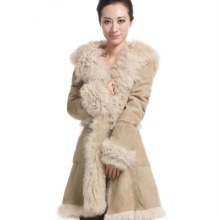
The benefits of a sheepskin are:
- Heat saving;
- Hygroscopicity;
- Heat regulation;
- Wear resistance and durability;
- Ease;
- Practicality;
- Ease of handling.
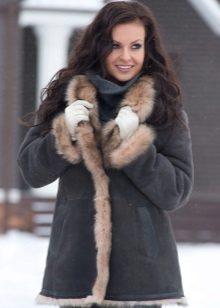





Sheepskin is used to make outerwear, hats, mittens and gloves, and is used as a lining and trim for clothes, bags, etc. The yarn is used to spin threads used in the manufacture of knitted items, carpets and various household items. The use of sheep skin also has wide ranges.

The most popular type of outerwear is a sheepskin sheepskin coat, originating from sheepskin coats and elements of national clothing of mountain peoples.




The name "sheepskin coat" comes from the technology of processing a sheepskin when it is tanned to make the skins stronger and wear-resistant. The fur also lends itself to processing - cutting, plucking. Sheepskin sheepskin coat has undoubted advantages even in severe climatic conditions, protects from wind and rainfall. Mostly modern models are focused on demi-season, but options for cold winters are also presented..
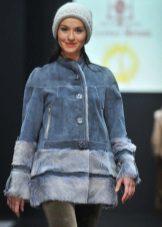



Modern technologies for processing fur and natural materials make it possible to make sheepskin products lightweight, durable, with various impregnations from precipitation, dust and dirtproof, easily dyed.
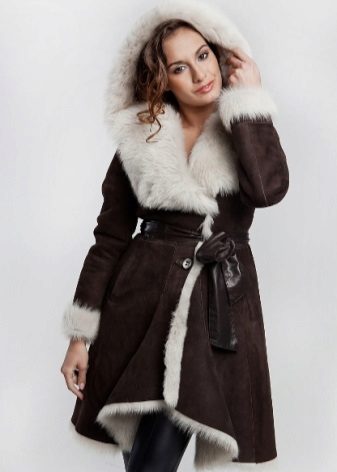



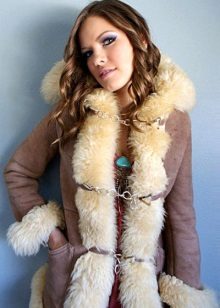
Fashion models
The classic models of sheepskin coats of different lengths, fur processing, decoration and additional elements are in constant demand. Each fashionista can choose an option for both winter and cold autumn.
Classic straight-cut models with a belt, various variations of the collar or hood, the presence of pockets on buttons always remain relevant. In the same series, you can include models of fitted, semi-fitted and A-silhouette.






The variety of collars is amazing - turn-downs, stands, shawl-style and in the style of "Chanel", "Jacqueline", etc.


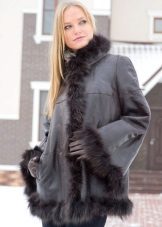


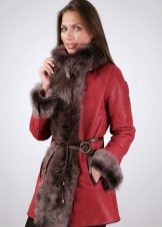
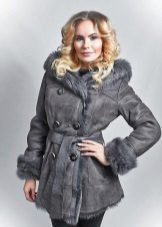

The sleeve of classic models, as a rule, is long either simple or with a fur cuff trim, including another, or with lapels, belt loops, decorative buttons, stones, zippers, etc.


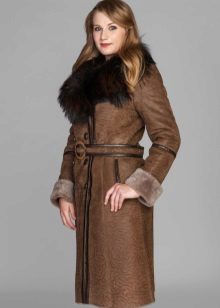
Modern models are distinguished by minimalism and practical cut. Young people fell in love with ultrashort and short “jacket” versions of sheepskin coats. Such models are complemented by elements such as zippers, contrast fasteners, buttons. The version of sheepskin coats is popular. On the lower edge, a cuff or adjustable fastener in the form of a button, zipper is possible as a traction element to protect against blowing.



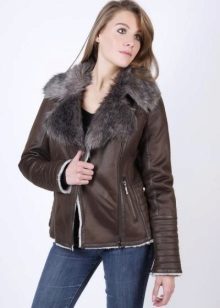

Models of a straight cut up to the middle of the thigh of the Raglan style or oversize were also included in the sheepskin fashion.






The technology of tailoring and dressing of sheepskin has undergone significant changes over the past decades, and allow designers to realize unlimited fantasies in models of sheepskin coats.





For the winter version, many will like two-sided models consisting of a sheepskin coat and fur. Or a model on a sheepskin inside, and on top covered with glossy leather. Lovers of an active lifestyle like these models very much because of practicality, durability, excellent heat-saving qualities and lightness. These sheepskin coats can be worn on either side.

Various impregnations (napalan, crack, etc.) and staining in bright colors brought an even greater variety to the model range.






A separate place is occupied by military style sheepskin coats such as a pea jacket, uniform or frock coat, characterized by double-breasted, collar. additional decoration in the form of shoulder straps, loops, stripes. These models can be straight cut or slightly flared from the waist.





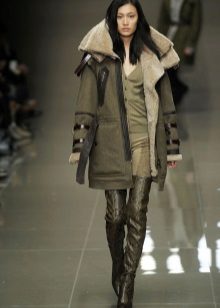
The latest fashion trends dictate using as few decorative elements as possible in sheepskin coats, and fur and clear cut lines are considered the main decoration.
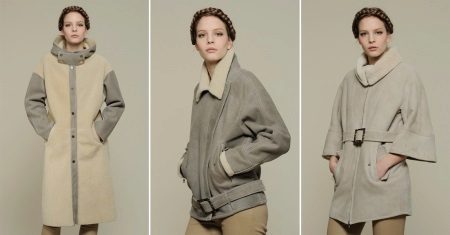
Types of Sheepskin
Sheepskin is produced worldwide and there are about 600 breeds of sheep whose skins are used for textile production.



There are sheepskin according to several signs:
- The structure of the hair and pile is fine-fleece, coarse-haired, half-fine-coarse, semi-coarse-haired;
- Species and quality of fur: Russian, Mongolian, steppe, Romanovskaya, etc.
- Types of origin and method of processing - moire, glue, smushka, merlushka, merino, Tuscany, tigrado, merinillo, etc.






Consider some types of sheepskin, most often used in the manufacture of sheepskin coats.
- Tuscany Sheepskin - wool of lambs of a long-haired fine-fleeced sheep bred in Spain on the Perinei. It is characterized by a thick and dense undercoat, long silky hair, polished outer surface. It is used for tailoring warm and elegant sheepskin coats.

- Merino - a sheepskin from the skins of fine-fleece merino sheep, with a long pile of thin curly hair. Merino wool and fur have softness and heat protection, as well as healing properties. In addition, such a fur is hygroscopic and an excellent heat regulator.

- Merinillo is also obtained from sheepskin of fine-wool breeds, only these skins are small in size and the fur is even softer and thinner.

- Enterfino Sheepskin - a semi-coarse or coarse-haired species obtained from the corresponding sheep breeds. It is characterized by thicker wool and dense coat, which makes the products wear-resistant and durable.

- Tigrado is a sheepskin derived from Spanish or Italian sheep breeds.It has very curly nap curls, which gives it an unusual look, at the same time it retains excellent heat-conducting qualities with its lightness. Often compared along with Tuscany.

Also in sheepskin coats use astrakhan fur, a muton.

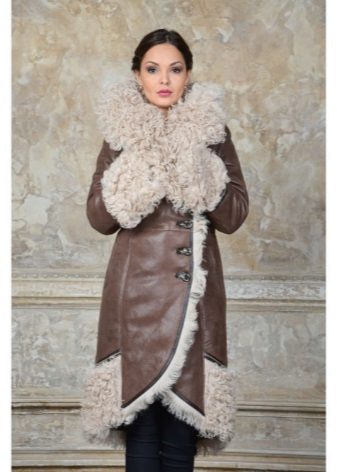
They are distinguished in sheepskin coats and types of coatings:
- Nappalan looks very similar to genuine leather with a smooth, glossy surface. Obtained by adding water-repellent impregnation and artificial leather. Such a coating is not afraid of precipitation.


- The crack appears to be composed of flakes, as it were, due to the hot oil application technology.


- The pool-up looks very glossy and like stretched skin. Such an impregnation is obtained by adding rubber. Often used for sheepskin coats.



In addition, there is also a natural coating in the form of a natural mezra. But the impregnations significantly increase the wearing time of the sheepskin coat, protect not only from rain and moisture, but also from dirt. Natural Mezra is more prone to contamination.

Length
How long your sheepskin coat will be entirely depends on your preference and the model you choose. Shortened sheepskin coats are relevant, as always, of medium length, to the knees and slightly lower.

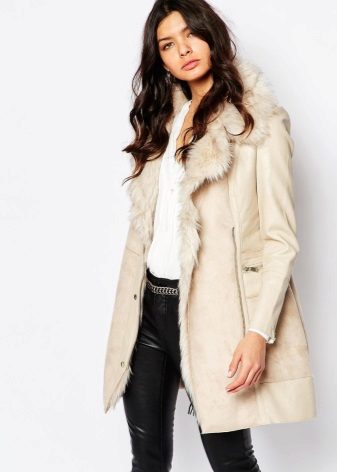



Current trends dictate the length of the sheepskin coat to the middle of the thigh or ultrashort to the waist.



Classic models adhere to the classics and in length - above the knees, to the knees, maxi-length.






Color
Sheepskin sheepskin coats are excellently painted in any colors - yellow, pink, blue, green, lime, white, fuchsia, orange, mustard, etc.

Classical models are designed in natural colors or classic colors - sand, beige and all shades of brown, gray, black, burgundy, navy blue, white, etc.






Interesting models are the use of contrasts - the black sheepskin coat is trimmed with white fur, or red, etc.



Novelties of recent seasons are drawings and patterns on a sheepskin coat.

The most important thing when choosing a sheepskin coat color is to take into account the practicality of wearing and care, as well as whether the color is suitable for your type of appearance and figure. Young people usually opt for bright and unusual colors of sheepskin coats, middle-aged people and the older generation prefer classics.

Black, blue, beige, brown, red remain popular.



How to choose?
When choosing a sheepskin coat you should pay special attention to such points:
- Size and model - a sheepskin coat should suit you both in size and style. Plus a sheepskin coat is that they fit perfectly on the figure, without loading the silhouette. Therefore, visually a sheepskin coat should not seem small or too big, should not limit you in your movements and hinder you.
- Details of the cut - they should be uniform, correctly sitting, without tension and distortions. Pile of fur velor should be taken into account when tailoring, i.e. its direction.
- The quality of the seams - the seams in sheepskin coats, as a rule, are processed with a double seam, without puffs and crooked stitches, protruding threads, etc.
- Product quality - a sheepskin coat needs to be examined and felt. The coating should not break or crack after touching or creasing. A quality sheepskin immediately takes on its shape after being crushed. Pile should be uniform throughout the product, without differences and bald spots, the same density and height.
- The color of the sheepskin coat should be uniform.







Given these recommendations, choosing “your” sheepskin coat - high-quality and comfortable - is not difficult. The durability of a sheepskin coat can be up to 18-20 seasons with proper care and wear.


How much is?
The price range for sheepskin sheepskin coats depends on the type and quality of raw materials, the technology of tailoring and processing of sheepskin, the manufacturer and the country for which the goods are oriented. It is no secret that sheepskin and raw materials for sheepskin coats are processed differently for different climatic conditions.


In general, the prices for sheepskin coats are quite affordable and affordable. Prices range from 20 tr. up to 50 tr Exclusive models from leading designers and high-quality raw materials are expensive purchases and their prices are akin to elite furs.


Stylish looks
TOA classic sheepskin coat with buttons on the button, half the length of the calf, rich red color with a belt. The collar and cuffs are trimmed with elegance and chic with sable fur using the “cross” technique. The piquancy and quality of the cut is emphasized by decorative oblique seams throughout the sheepskin coat. The model is suitable for confident and stylish women, leading a business and active lifestyle. Such a sheepskin coat is suitable for daily wearing and going out.

Romance and extraordinaryness of this model of a sheepskin coat are given by the textured finish of the hem and collar with sheepskin tigrado fur. Shearling coat of a straight cut with a turn-down collar, on a belt, knee-length. Finishing a tigrado on the hem with a wide strip from the middle of the thigh to the knees gives comfort and softness to the image. Conservative black color balances the sort of "hooliganism" of the model with its seriousness. At the same time, this sheepskin coat is easy to combine and combine with any details of the wardrobe, and choosing accessories for it will not become a “headache”. This sheepskin coat is a great solution for young and active girls.

An incredibly fashionable sheepskin coat with a straight cut keeps one more secret - a two-sided model. And if one side is made in a “leather” version with a minimum of details in a beautiful gray color, then the second side will please with an unusual “fur” look of sapphire color, and the same cut details look like a new model. Shearling coat of a straight cut, medium length, without a collar with a V-neck of a neck in the form of a rack, on buttons with a long sleeve and a belt. The sleeve line is slightly lowered, which, in combination with the neck, looks very harmonious. Patch volumetric pockets with a clear geometric shape give the model an ultramodernity. Fur patch pockets are made of sheepskin with a long pile and in another color - gray.


The belt on the fur side of the sheepskin coat is a leather narrow strap in the form of a tow, tied in a knot or bow. This model will be a godsend for many lovers of sheepskin coats, because the result is two complete models of sheepskin coats.










